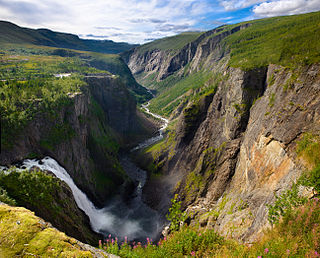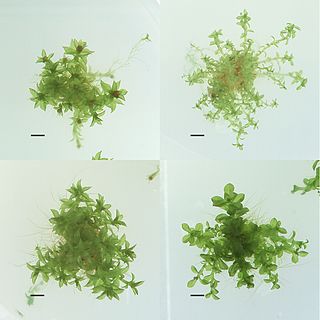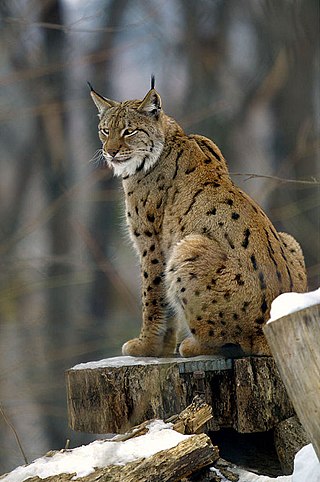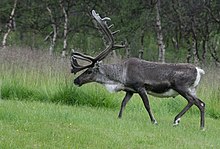
The moose or elk is a member of the New World deer subfamily and is the only species in the genus Alces. It is the largest and heaviest extant species in the deer family. Most adult male moose have distinctive broad, palmate antlers; most other members of the deer family have antlers with a dendritic ("twig-like") configuration. Moose typically inhabit boreal forests and temperate broadleaf and mixed forests of the Northern Hemisphere in temperate to subarctic climates. Hunting and other human activities have caused a reduction in the size of the moose's range over time. It has been reintroduced to some of its former habitats. Currently, most moose occur in Canada, Alaska, New England, New York State, Fennoscandia, the Baltic states, Poland, Kazakhstan, and Russia.

Antlers are extensions of an animal's skull found in members of the Cervidae (deer) family. Antlers are a single structure composed of bone, cartilage, fibrous tissue, skin, nerves, and blood vessels. They are generally found only on males, with the exception of reindeer/caribou. Antlers are shed and regrown each year and function primarily as objects of sexual attraction and as weapons.

The reindeer or caribou, is a species of deer with circumpolar distribution, native to Arctic, subarctic, tundra, boreal, and mountainous regions of Northern Europe, Siberia, and North America. This includes both sedentary and migratory populations. It is the only representative of the genus Rangifer. Herd size varies greatly in different geographic regions. More recent studies suggest the splitting of reindeer and caribou into 6 distinct species over their range.

Eidfjord is a municipality in Vestland county, Norway. The municipality is located in the traditional district of Hardanger. The administrative centre of the municipality is the village of Eidfjord, where the majority of the municipal population lives. The other major population centre in the municipality is the village of Øvre Eidfjord.

The muskox, also spelled musk ox and musk-ox, plural muskoxen or musk oxen, is a hoofed mammal of the family Bovidae. Native to the Arctic, it is noted for its thick coat and for the strong odor emitted by males during the seasonal rut, from which its name derives. This musky odor has the effect of attracting females during mating season. Its Inuktitut name "umingmak" translates to "the bearded one".

In evolutionary ecology, an ecotype, sometimes called ecospecies, describes a genetically distinct geographic variety, population, or race within a species, which is genotypically adapted to specific environmental conditions.

The migratory woodland caribou refers to two herds of Rangifer tarandus that are included in the migratory woodland ecotype of the subspecies Rangifer tarandus caribou or woodland caribou that live in Nunavik, Québec, and Labrador: the Leaf River caribou herd (LRCH) and the George River caribou herd (GRCH) south of Ungava Bay. Rangifer tarandus caribou is further divided into three ecotypes: the migratory barren-ground ecotype, the mountain ecotype or woodland (montane) and the forest-dwelling ecotype. According to researchers, the "George River herd which morphologically and genetically belong to the woodland caribou subspecies, at one time represented the largest caribou herd in the world and migrating thousands of kilometers from boreal forest to open tundra, where most females calve within a three-week period. This behaviour is more like barren-ground caribou subspecies." They argued that "understanding ecotype in relation to existing ecological constraints and releases may be more important than the taxonomic relationships between populations." The migratory George River caribou herd travel thousands of kilometres moving from wintering grounds to calving grounds near the Inuit hamlet of Kangiqsualujjuaq, Nunavik. In Nunavik and Labrador, the caribou population varies considerably with their numbers peaking in the later decades of each of the 18th, 19th and 20th centuries. In 1984, about 10,000 caribou of the George River herd drowned during their bi-annual crossing of the Caniapiscau River during the James Bay Hydro Project flooding operation. The most recent decline at the turn of the 20th century caused much hardship for the Inuit and Cree communities of Nunavik, who hunt them for subsistence.

The Porcupine caribou(Rangifer tarandus groenlandicus) is a herd or ecotype of barren-ground caribou, the subspecies of the reindeer or caribou found in Alaska, United States, and Yukon and the Northwest Territories, Canada. A recent revision changes the Latin name; see Taxonomy.

Hardangervidda National Park, at 3,422 square kilometres (1,321 sq mi), is Norway's largest national park. It spans from Numedal and Uvdal in the east and Røvelseggi and Ullensvang in the west across the Hardanger mountain plateau (Hardangervidda). Designated as a national park in 1981, today it serves as a popular tourist destination for activities such as hiking, climbing, fishing, and cross-country skiing. The Norwegian Mountain Touring Association (DNT) maintains a comprehensive network of huts and paths across Hardangervidda. The Bergen Line and the main Highway 7 cross the plateau. The park lies in Viken, Vestland, and Vestfold og Telemark counties.

The Peary caribou is a subspecies of caribou found in the High Arctic islands of Nunavut and the Northwest Territories in Canada. They are the smallest of the North American caribou, with the females weighing an average of 60 kg (130 lb) and the males 110 kg (240 lb). In length the females average 1.4 m and the males 1.7 m.

The barren-ground caribou is a subspecies of the reindeer that is found in the Canadian territories of Nunavut and the Northwest Territories, in northern Alaska and in south-western, Greenland. It includes the Porcupine caribou of Yukon and Alaska. The barren-ground caribou is a medium-sized caribou, smaller and lighter-colored than the boreal woodland caribou, with the females weighing around 90 kg (200 lb) and the males around 150 kg (330 lb). However, on some of the smaller islands, the average weight may be less. The large migratory herds of barren-ground caribou take their names from the traditional calving grounds, such as the Ahiak herd, the Baffin Island herds, the Bathurst herd, the Beverly herd, the Bluenose East herd, the Bluenose West herd, the Porcupine herd and the Qamanirjuaq herd.

Reindeer hunting in Greenland is of great importance to the Greenlandic Inuit and sports hunters, both residents and tourists. Reindeer (caribou) are an important source of meat, and harvesting them has always played an important role in the history, culture, and traditions of the Greenlandic Inuit. Controlled hunting is important for the welfare of reindeer, the quality of life for Inuit, both as food, and part of the their culture and Greenlandic culture in general, and the preservation of tundra grazing areas. Therefore, scientific research is regularly performed to determine the quotas needed to maintain a proper ecological balance.

The Finnish forest reindeer(Rangifer fennicus fennicus, also known as Eurasian or European forest reindeer is a rare subspecies of the reindeer native to Finland and northwestern Russia. They are found primarily in Russian Karelia and the provinces of North Karelia, Savonia and Kainuu in Finland, though some range into central south Finland. They are distinct from the semi-domesticated mountain reindeer in their larger size, longer legs and preference for dense boreal forest habitat, where they are rarely seen by humans, over the open tundra. The Finnish herd migrates seasonally back and forth across the long Russo-Finnish border.

The Svalbard reindeer is a small subspecies or species of reindeer found on the Svalbard archipelago of Norway. Males average 65–90 kg (143-198 lb) in weight, females 53–70 kg (116-154 lb), while for other reindeer generally body mass is 159–182 kg (350-400 lb) for males and 80–120 kg (176-264 lb) for females.

The boreal woodland caribou, also known as woodland caribou, boreal forest caribou and forest-dwelling caribou, is a North American subspecies of reindeer found primarily in Canada with small populations in the United States. Unlike the Porcupine caribou and barren-ground caribou, boreal woodland caribou are primarily sedentary.

Reindeer in Russia include tundra and forest reindeer and are subspecies of Rangifer tarandus. Tundra reindeer include the Novaya Zemlya (R.t.pearsoni) and Sápmi subspecies and the Siberian tundra reindeer.

The northern lynx is a medium-sized subspecies of the Eurasian lynx.
Caribou herds in Canada are discrete populations of seven subspecies that are represented in Canada. Caribou can be found from the High Arctic region south to the boreal forest and Rocky Mountains and from the east to the west coasts.

The reindeer is a widespread and numerous species in the northern Holarctic, being present in both tundra and taiga. Originally, the reindeer was found in Scandinavia, eastern Europe, Russia, Mongolia, and northern China north of the 50th latitude. In North America, it was found in Canada, Alaska, and the northern contiguous USA from Washington to Maine. In the 19th century, it was apparently still present in southern Idaho. It also occurred naturally on Sakhalin, Greenland, and probably even in historical times in Ireland. During the late Pleistocene era, reindeer were found further south, such as at Nevada, Tennessee, and Alabama in North America and Spain in Europe. Today, wild reindeer have disappeared from many areas within this large historical range, especially from the southern parts, where it vanished almost everywhere. Populations of wild reindeer are still found in Norway, Finland, Siberia, Greenland, Alaska, and Canada.




















